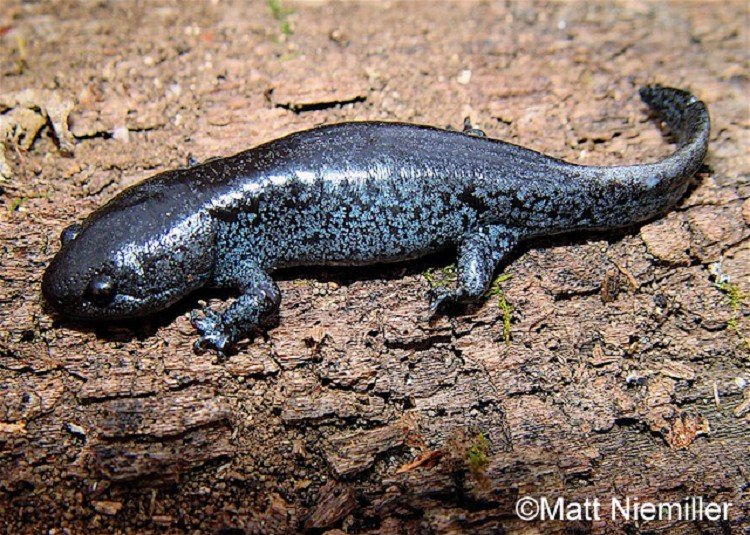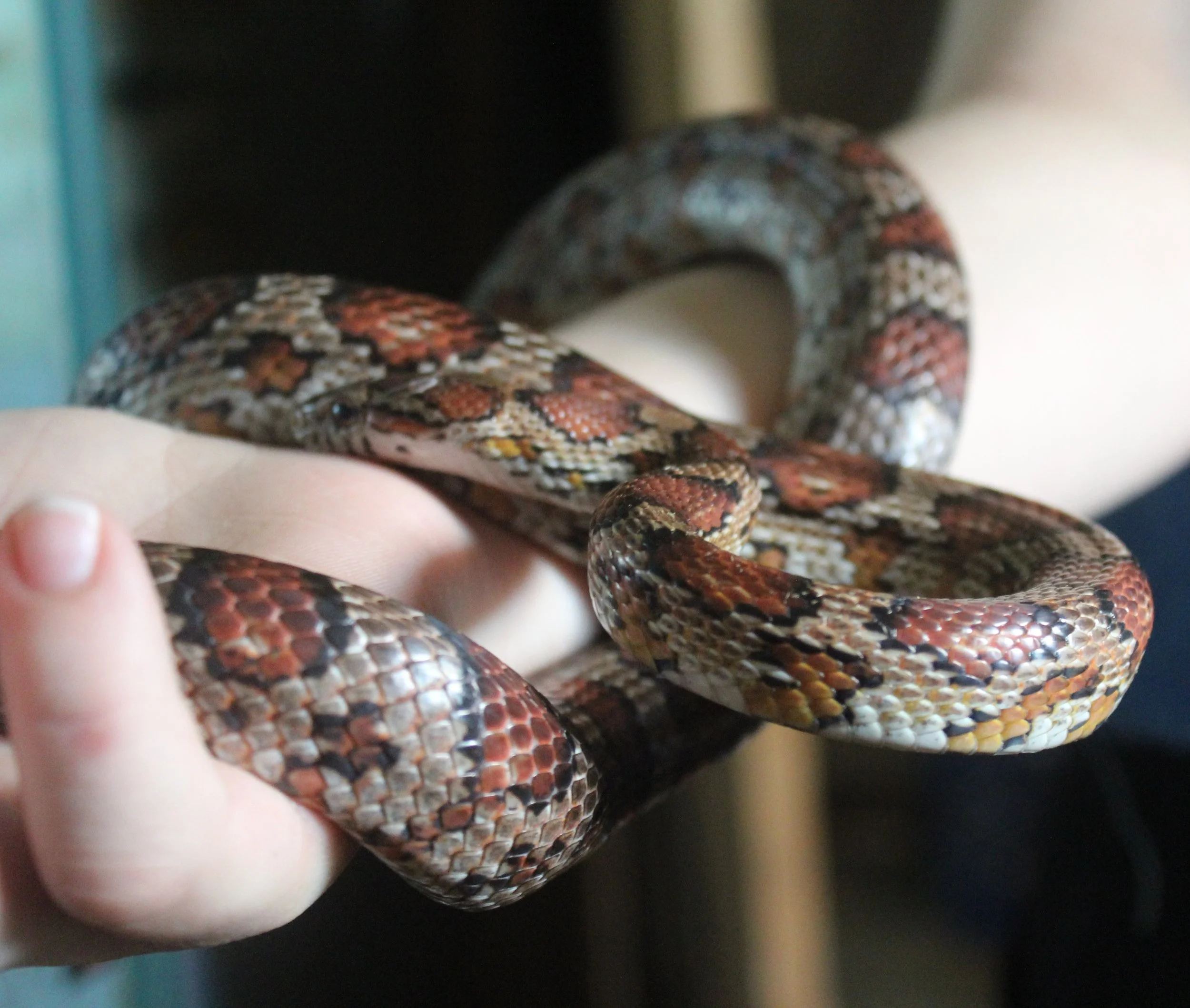Updated March 3, 2022
Salamanders are a unique group of animals. They are amphibians, like frogs, and may live in water or on land. There are 35 species of salamanders that live in Kentucky.
We have ten species that are completely terrestrial and twenty-five that are aquatic for at least part of their lifespan. Salamanders are a critical indicator of ecosystem health and an important part of the food web.
This article will discuss the characteristics and habits of salamanders, conservation, diseases, and will introduce you to a number of species found in our state of Kentucky.
What Makes A Salamander?
A salamander is a small lizard-like animal but are amphibians not a reptile. They are ectotherms (cold-blooded) and have a backbone. During hot weather, they may hide in shady areas away from the sun and in the winter they brumate like other reptiles.
Read our article NIGHTY NIGHT, SLEEP TIGHT! HIBERNATION, BRUMATION AND TORPOR EXPLAINED
Photo credit: Franco Andreone http://calphotos.berkeley.edu
Most salamanders lay their eggs in the water and have aquatic larvae like frogs. As larvae, they use gills to breathe and later change to lungs to take in oxygen.
Their skin is cool, moist and permeable. Permeable skin allows liquids and gases to pass through the skin. This helps the salamander to breathe. It also means they get dried out easily so they need to stay close to water.
Metamorphosis
Salamanders lead a double life. Just like having a secret identity. In fact, the word amphibian means double life in Greek.
Salamanders, like frogs, have two distinct life stages. They have a larval stage and an adult stage. Salamanders begin life as eggs and experience an amazing transformation as they grow from a larval stage to an adult stage. This transformation is called metamorphosis.
Senses
Salamanders use their senses to hunt for prey and find mates. They are able to see and see especially well at night. They can see colors and have trichromatic color vision.
Predators
You may not think of salamanders as predators but they are. Even the larvae. All species hunt for their food. Salamanders mostly eat insects, worms, and small crustaceans.
They are also prey for many animals including snakes and birds.
Conservation
Salamanders around the world are in danger. More than 1,800 amphibian species around the globe are threatened in danger of becoming extinct. That’s 32% of the total for all amphibian species. At least 43% of all amphibian species are suffering population declines. (Source)
In the state of Kentucky 14 salamanders are under a conservation watch. This is due to habitat loss and pollution of waterways among other issues.
Kentucky has a very diverse population of salamanders and is considered to be one of the most bio-diverse ecological niches for amphibians. We must all work hard to protect their habitat.
Important Conservation Techniques to advocate for:
Kentucky Streamside Management Zones
Partial tree harvest vs. clearcutting which seriously reduces habitat
Minimize soil disturbance during construction of homes and roads
Helping Salamanders
There are lots of things that you can do to help salamanders. Providing wildlife habitat in your yard and making it salamander friendly is a great way to provide them with places to breed and look for food.
Salamanders need dark, cool places to hide during the day. Old logs, rocks, and patio stones make good habitat for them. I once moved a large plastic dog house and saw two spotted salamanders scurry away.
You can have an amphibian friendly pond - yes that would be a fish pond with no fish. The fish feed on the frog and salamander eggs. If you build a backyard pond you can add plants and rocks along the edges. This makes a great place for amphibians to lay their eggs.
A shallow stock tank makes a great small pond for your salamander and frog friends.
Check out our organic gardening blog to learn more about growing vegetables and becoming self-sufficient!
Salamander Chytrid Fungus
The fungus, Batrachochytrium salamandrivorans, (Bsal) has been decimating salamander populations around the world. It is believed to have started in Asia and quickly spread to Europe. In some countries, an estimated 96% mortality rate has been seen in certain species.
This disease is not yet harming salamanders in North America, however, we want to be vigilant to protect our amphibian populations. We are an important country for salamander diversity and home to nearly fifty percent of all species.
Bsal is spread by the introduction of exotic salamanders from the pet trade. People sometimes release pet salamanders into the wild. In addition, contaminated water, and waste from pet salamanders can pollute area habitats.
The Kentucky Department of Fish and Wildlife makes these recommendations:
Don’t release pet salamanders outside in the wild.
For pet salamanders, treat the wastewater before disposal. You can do this by adding bleach in a 1:10 part solution.
Pet salamanders can be tested for Bsal. You can order a free test kit from Salamander Fungus.
Salamander Species
Allegheny Mountain Dusky Salamander
(Desmognathus ochrophaeus)Lives in the Appalachian Mountain range from New York southward into Tennessee. Occurs in the Cumberland Mountains in extreme southeastern Kentucky and scattered populations occur elsewhere in eastern Kentucky.
They are declining in Kentucky due to habitat loss and the recent increase in mountaintop removal surface mining in the Cumberlands.
They live in moist banks, stream heads, seeps, wet spots, and cool moist forests.
Fun Fact: Stays active during winter in underground dens and fast-moving streams.
Black Mountain Salamander
A common salamander (Desmognathus welteri) in eastern Kentucky, as well as portions of West Virginia, Virginia, and Tennessee, are most common where there is protected habitat.
Red River Gorge, Cave Lake, and Black Mountain have sustainable populations.
Sadly, numbers are declining in eastern Kentucky due to habitat loss and water pollution. This species can’t tolerate silt in the water. They are often found in streams with small waterfalls or in the entrance of caves.
Interestingly, they like habitats at higher elevations and live around mountain streams and rocky headwater creeks.
Cumberland Plateau Salamander
Lives in a variety of woodland habitats, rocky outcrops, and cave entrances.
The Cumberland Plateau (Plethodon kentucki) salamander is a completely terrestrial species. They lay their eggs underground in moist areas in the springtime.
They are considered a fairly common species and described as one of least concern. However, they have declined in population from several areas in Kentucky including Northeastern counties and the Ashland area.
Eastern Hellbender
Coolest Salamander Ever! (My opinion)
Lives primarily along the Ohio River watershed from southern New York to Northern Alabama. It is widespread in Kentucky Rivers including the Licking, Kentucky, Green, Barren, and Cumberland waterways. They prefer fast-moving streams with riffles.
They are large salamanders and get to be 12 to 29 inches long and weigh five pounds. They live an average of twenty-five years and do not become sexually mature until they are five years old.
The Eastern Hellbender(Cryptobranchus alleganiensis) is seeing population declines. They have a low tolerance for silt and chemicals in the water. They require water with a high level of oxygen.
This video shows the release of Hellbender Salamanders in SE Ohio at Yellow Creek.
FUN FACTS:
Hellbenders have vestigial lungs which means they dont functon as lungs. Hellbenders breathe through their wrinkley skin.
The hellbenders' bodies are covered in mucus - that’s where they get the nckname Snott Otter! The mucus tastes bad to enemies and it protects them from parasites.
The males create a cavity under a rock and then coerice the female to enter the nesting site.
Long-Tailed Salamander
The Long Taled Salamander (Eurycea longicauda) is named so because their slender tail is much longer than the body. Typically they are yellow to bright red-orange, with scattered black spots, especially along their sides.
They live nearby creeks and may occasionally go into the forest in search of prey. In Kentucky, we often see them near the mouths of caves or abandoned mines. Eggs are laid in underground crevices within or near streams or springs.
They grow up to eight inches long - but that is mostly tail! They live about ten years.
FUN FACT:
Males and females rub their heads together during courting.
Long Tailed Salamander - Photo by Steve Prutz
Mole Salamander
The mole salamander (genus Ambystoma) is an adorable short pudgy species of only three to four inches in length.
They are found in Western Kentucky and are common along the Mississippi River and the coastal south. Larvae and neotenic adults prefer fishless wetlands and adults are often found in evergreen forested areas.
They are nocturnal and burrow underground or beneath logs during the day.
Fun Fact: They are facultatively paedomorphic. This means they can decide when to metamorphosis. They may have larval characteristics as adults such as gills and continue to live in water. They may also go through metamorphosis and live in the terrestrial environment.
Mole Salamander. Photo by Matt Niemiller. Tennessee Wildlife Resources Agency.
Red-backed Salamander
The red-backed salamander (Plethodon cinereus) has short legs and a tail and has a red or orange-colored strip down their back. They rarely exceed four inches in total length and are common in woodlands in the Eastern USA. Lives under the leaf litter and old logs n woodland areas.
They mate in autumn however the females retain the sperm and fertilize the eggs in spring. They lay eggs under logs and rocks. Hatchlings look like adults only smaller.
Their larvae have no aquatic stage like many other salamanders. You may see them around your garden because they love earthworms.
FUN FACTS:
The red-backed salamanders have an interesting way of getting away from predators. They can drop all or part of their tail if they are captured. Then they run away. They can grow a new tail but it takes some time.
Red-backed salamanders live a long time. Up to twenty-five years in captivity.
They lack lungs. They breathe through their skin.
Spotted Salamander
Very beautiful with a blue-black to the dark gray body and two irregular rows of yellow or orange spots that run the length of the body. The underside is a slate gray color. Related to the mole salamander.
The Spotted Salamander (Ambystoma maculatum) is found in hardwood forests and hillsides usually close to ponds, these are another spring-breeding species that migrate during the rainfall.
March and April are the best time to spot them as they are typically very secretive.
They often lay eggs in vernal pools which reduces fish preying on the eggs but allows the young enough water to complete metamorphic development.
Fun Fact:
When disturbs it secrets a toxic milky liquid that is stored in glands by the neck.
Uses its sticky tongue to catch prey.
Subscribe to my YouTube Channel for lots of great wildlife conservation videos
How To Find Salamanders
*** Remember that salamanders are delicate. Never handle a salamander with dry hands as you can damage their skin. Don’t hold them in the sun. Handle them at ground level in case they jump free.
*** Also some salamanders excrete toxic substances which can cause you to have a burning sensation or itching.
A good guide to Kentucky wildlife includes salamanders
Know Where To Look. In Kentucky, the best places to look are along streams and in the woods. Read my article on finding salamanders.
Try looking in both day and nighttime. Some species are nocturnal. Use a flashlight on low beam to look for them moving around and hunting. During the day they hide under logs and stones in or out of a creek.
They like the rain. Spring rains bring them out and about.
Author, Ame Vanorio is a certified science teacher, environmental educator, and organic farmer. She is the director of Fox Run Environmental Education Center and a licensed wildlife rehabilitator.













Owls are fascinating. Nocturnal, secretive, and fierce predators. They stimulate our imaginations and have a rich history in literature.